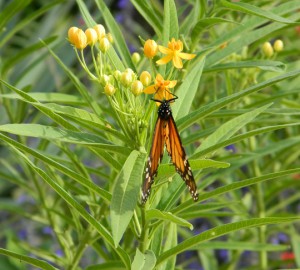It’s monarch migration season in central Texas. As with many pollinators, there is growing concern about the decline in monarch populations. Fortunately, there are some simple things gardeners can do to help these fluttering beauties.
Of course, you need a caterpillar before you can have a butterfly and the monarch caterpillar is a picky eater. It feeds exclusively on the plant genus Asclepias, better known as the milkweed family. As Texas is on the flyway for migrating monarchs on their way to winter over in a single forest in Michoacán, Mexico, there are native milkweeds for them to lay eggs on which hatch into voracious caterpillars. These native plants are hard to grow, but you can buy seed and give it a try.
The more charismatic Mexican milkweed available at local nurseries is the tropical milkweed (Asclepias curassavica). If you plant these in your yard, plant extra for the caterpillars to munch on, but be sure to buy “butterfly friendly” plants. Carefully question your retail nursery to see if they have sprayed the plants with pesticides or if the grower they get them from has sprayed the plant. Those are the plants you don’t want.

This monarch butterfly (Danaus plexippus) takes a break to feed on yellow milkweed (Asclepias curassivaca).If it is a female, the butterfly may also lay some eggs on the plant as well.
While milkweed is the only food source for monarch caterpillars, the popular tropical milkweed is also a favorite of the dreaded aphids. Because these plants are susceptible to aphids, growers don’t want to deliver aphid-infested plants to the nurseries for obvious reasons. They often use systemic pesticides that absorb into the plant and don’t wash or wear off, making them immediately fatal to monarch caterpillars as well as all insects, beneficial or not.
This is where a few aphids are a good sign. It means that tropical milkweed won’t be poisonous to the monarch caterpillars. If you what to thin the aphid herd wash them off with water, but be careful not to disturb the caterpillars.
While the caterpillars are picky eaters, the monarch butterfly is not. Include a host of nectar plants for the butterflies and don’t water with a sprinkler. Instead water by hand at the base of the plant to preserve the nectar. As always a balanced landscape is a healthy landscape.


